

 Vol. 39 (# 25) Year 2018. Page 10
Vol. 39 (# 25) Year 2018. Page 10
Edilberto Antonio LLANES Cedeño 1; Juan Carlos ROCHA - Hoyos 2; Diana Belén PERALTA Zurita 3; Javier Martínez Gómez 4; Santiago CELI Ortega 5
Received: 06/02/2018 • Approved: 05/03/2018
ABSTRACT: The teaching and learning system is currently undergoing an accelerated transformation to answer the necessity of knowledge society. The research objective was to evaluate the evolution of the learning of the mechanical engineering students, through the implementation of integrating projects. The research topic, took into account several subjects of the syllabus in order to analyze soft and hard skills based in field activities. Results of the survey concluded that work by project achieved a deeper development of knowledge and teamwork. |
RESUMEN: El sistema de enseñanza y aprendizaje está actualmente experimentando una transformación acelerada para responder a la necesidad de la sociedad del conocimiento. El objetivo de la investigación fue evaluar la evolución del aprendizaje de estudiantes de ingeniería mecánica, a través de la implementación de proyectos integradores. El tema de investigación, tomo en cuenta varias materias del plan de estudios con el fin analizar habilidades suaves y duras basadas en actividades de campo. Los resultados de la encuesta indican que el trabajo por proyecto logró un desarrollo más profundo del conocimiento y el trabajo en equipo. |
In recent years, much interest has been expressed in innovative pedagogical approaches as new educational practices. This practices have been used in higher education by Porter, Graham, Spring, & Welch, (2014) or; Nicol, Thomson, & Breslin, (2014).
Project-based learning (PBL) is an example of an innovative pedagogical approach widely used today. This method is based in acquiring knowledge and skills promotes, among other things, problem solving, creativity and critical thinking (Ding, 2016). It also encourages students to become self-taught learners and to work cooperatively in small groups to find solutions to problems (Chatwattana & Nilsook, 2017). Above all, PBL helps students understand and contextualize the lessons that are sometimes too theoretical through the use of case studies (Gregorio, Ignacio, Prats, Villardi de Montlaur, & García-Berro, 2008, Jacques, Bissey, & Martin, 2016).
Faculty of Automotive Mechanical Engineering in Universidad Internacional SEK has integrated projects carried out by research programs. These projects allow students linking in activities practices that relate to various subjects of the syllabus. In this way, use of biodiesel as an alternative fuel in diesel internal combustion engines is one of the research projects that has been carried out. For this knowledge, it is especially important, the evaluation in relation to the emissions of combustion products and their energy behavior. To carry out this PBL, 30 students of mechanical engineering research on a common problem relating different subjects such as: Fuel and Lubricants, Control Emissions, Injection and Thermal Design. These analyzes allow to evaluate the diesel engine at 2850 m in dynamic measurement emissions as a contribution to the development and application of alternative fuels in transportation.
Chapter 2 text The research methodology includes a project preparatory phase, project team composition and member roles and Learning outcomes and evaluation methods.
A preparatory phase, carried out in the first semester of 2017, is essential to meet the project expectations, especially because the study is planned for the second half of an academic year (2017). During the preparatory phase, the route where the emission parameters are measured was characterized, the vehicle was selected, the measuring instruments was managed and other necessary supplies for the tests.
The key actions necessary to guarantee the success of the study are detailed below:
Three professors were in charge of the preparatory phase of the project. Of course, they also had to stimulate and evaluate the acquisition of knowledge and new competences during the duration of the project. For the 2016-2017 academic year, with regard to material resources, the funding assigned to the research project of the UISEK was included.
The work teams are selected from the subjects that are related to the project.
With respect to the new PBL approach described in this document, students were typically divided into several groups of 5 people. A group of approximately 5 students is particularly interesting because students must develop a proactive role in a comfortable learning environment. Such an atmosphere is useful to promote open discussions about the details of the project, and to define the roles and responsibilities of each student. A group setting also allows students to make mistakes without fear of criticism. This method was chosen to force them to work together, and promote dialogue, critical thinking and the exchange of knowledge. For all engineering students, the project represents a multidisciplinary and friendly product that reflects current environmental concerns in the transportation sector. The choice of this case study contributed greatly to maintaining their motivation throughout the project.
Each group of students was supervised by a teacher for 30 hours. The 3 teachers had 4 main roles. The first was to become a professional coach to provide advice and experience, and to make the right decisions, while managing risk and uncertainty around the project. The second was related to the coordination of the project, especially when paying attention to the activities of all the students and supervising their work. The third role was to be a motivator and a facilitator. In particular, the objective was to promote and support student motivation throughout the project. The last role was to evaluate the knowledge and skills acquired. This also included a comprehensive performance response for each student at the end of the project.
By the end of the project, students had to control the methods and tools that engineers must master to identify, model and solve specific problems. As can be seen in Table 1, four competences were taken into consideration which were particularly evaluated and recommended by Jacques (2017):
Table 1
Competencies evaluated, learning outcomes, evaluation methods
Competencies evaluated (C) |
Learning outcomes (LO) |
Expected level |
Evaluation methods |
C1. The ability to apply and develop the concepts of conversion of emissions volume to emission factor |
LO 1.1. Develop methods and tools to quantify emissions |
Application level* |
-Field experiments. -Oral presentation |
LO 1.2. Develop critical sections for analysis, and provide feedback |
|||
C2. The ability to develop measurements and characterization of the technical parameters of the vehicle and the relationship of each system in the results obtained |
LO 2.1. Get an overview |
Application level* |
-Group discussions and sharing resources and ideas - Oral presentation |
of the systems and equipment that influence the volume of emissions and relate each component to its impact on the environment. |
|||
C3. The ability to be part of a dynamic team, manage relationships with team members, and management development: leadership, commitment, project management and communication of results |
LO 2.2. Take decisions in appropriate scenarios to quantify their impact on the environment. |
Control level** |
-Field experiments. -Oral presentation - Work in the Notebook |
LO 3.1. Be a member of the team that encourages dynamic collaboration. |
|||
LO 3.2. Demonstrate leadership and proactivity in the execution of activities. |
-Work in the Notebook. -Frequent questions -Oral presentation |
||
C4 The ability to fit into professional and social life: team spirit, commitment and exercise in responsibility |
LO 3.3. Summarize the results and inform them in wider scenarios, including |
Control level** |
-Field experiments -Oral presentation -Work in the Notebook |
those without an experience and mastery of technique. |
|||
LO 4.1. Have an exemplary behavior (regular attendance, |
-Group discussions and sharing resources and ideas |
Note: * Application level: completion of the activity with assistance.
** Level of domain: completion of the activity independently.
Each group of students had to keep a record book throughout the project where the results obtained and project operational techniques were recorded and relevant calculations. The goal was to get all significant information on a day-to-day basis. Regarding the acquisition of practical skills and knowledge, two levels were defined:
- Level of application: corresponds to the realization of an activity with assistance. This level was required for the competitions called "C1" and "C2".
- Level of domain: corresponds to the performance of the activity independently. This level was requested for the competitions called "C3" and "C4" and taking into consideration what was referred by Cedeño & Jimenez (2017).
With respect to the first competition called "C1", the students had to control the reaction equations that occur in the MCI in order to identify the products emitted into the atmosphere. They must be able to quantify the emissions volumes and determine the emission factors.
The results obtained were presented in an oral section framed in the week of science, where each team explained the methodology and results obtained and their relationship with the engineering subjects.
The second competition called "C2" focused on the application during the experiment of the knowledge of metrology and emission measurement techniques. Teachers provided special oral sessions in the form of frequently asked questions, to ensure that all students acquire information and clarifications to help them adequately understand the challenges that were crucial to achieving the results of the project.
The third competition called "C3" focused on leadership, commitment, project management and communication actions. Members' responsibilities to the group were tested through various activities during the fieldwork. These activities motivated students to think about how teams should work together. The role of the teachers was crucial in that case, because they had to evaluate the capacity of each student for their integration in the work team. This task management chart was, among others, composed of the following elements:
The discussions allowed and encouraged the students to be proactive.
The last competition called "C4" evaluated the ability to adapt to teamwork with ethical and moral values. The objective was to increase the awareness and responsibility of students towards the rules and values of today's society. The following elements were evaluated by the teachers through a dynamic board: regular attendance and punctuality, thoroughness, involvement in the work.
At the end of the project, each group of students had to summarize the results of their research during a theatrical oral session. The audition is, in front of a jury of professionals in the engineering week and the presence of other students
In this section, a student research summary carried out during the development of the field activities is made. Special attention is paid to the measurements methodology of measurement and control of the instruments used during the experimentation.
Figure 1 show different means of measurement for the fuel quantification used by the students. For this task, they applied the knowledge acquired in the subjects of Metrology and the properties of the liquids taught in the matter Fuel and Lubricants.
Figure 1
Measurement and control of fuel
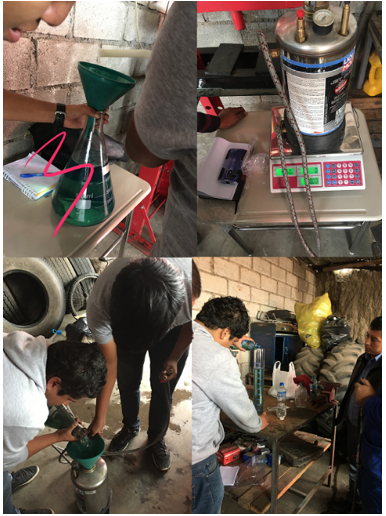
3.2 Consumption and emission quantification measurements
As shown in Figure 2, students had to control the installation process and emissions calculation (Llanes, Tipanluisa, Rocha-Hoyos & Portilla, 2017). For this task, students are being able to contact in practice with the necessary instruments and calculation methodology explained and shown through images and case studies in the classroom.
Figure 2
Emission equipment and
data control installation
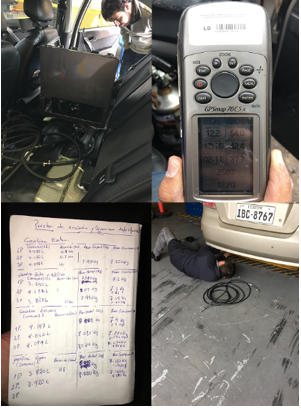
3.3 Results diffusion
The experiments results, as a final phase of the project, were exposed by each team during the engineering week and evaluated by a court with the student’s presence
Figure 3 shows the active project members participation, and a sample of the poster presented for the presentation of the results.
Figure 3
Oral presentation of the
projects results of the project
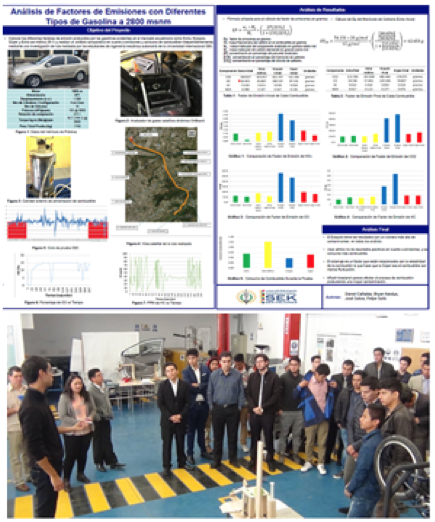
3.4 Satisfaction survey results
The student’s participation percentage in research projects can be seen in Figure 4. of in Figures 4 and 5 show the participation in a greater percentage of students in projects as a way of solving a specific problem. In figure 5 can be observed the kind of projects which the students had participated in the last ten years.
Figure 4
Participation in research project
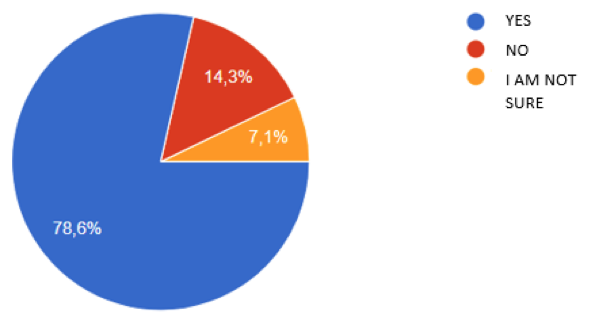
----
Figure 5
Participation in different
research project categories
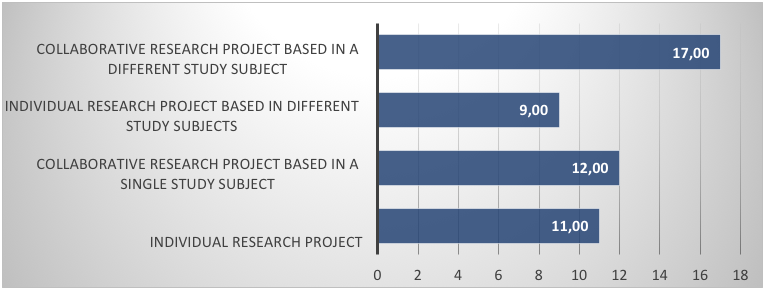
The students were evaluated to select the type of project in which you believe that you have obtained the greatest amount of soft, hard and skill competences, which contribute to professional development (Figure 6) The results demonstrate that 50% of students in a certain way prefer team work, where the contents of various subjects can be integrated
Figure 6
Projects incidence in the training
and strengthening of soft skills
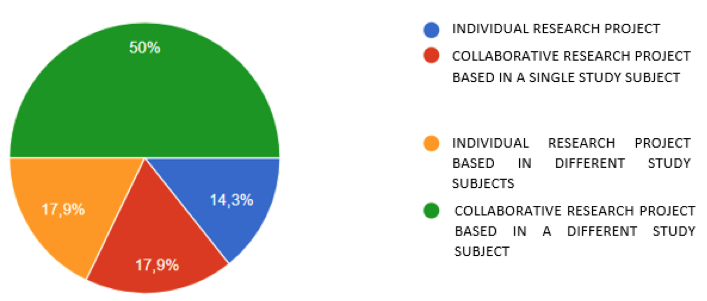
Recognition of soft skills in research projects can be observed in Figure 7. The results show how during the integration projects and the group work, the students identify that it has contributed not only to the strengthening of the hard competitions. But, o the soft skills have been strengthened especially the team work, search of information, responsibility, etc.
Figure 7
Recognition of soft skills in research projects
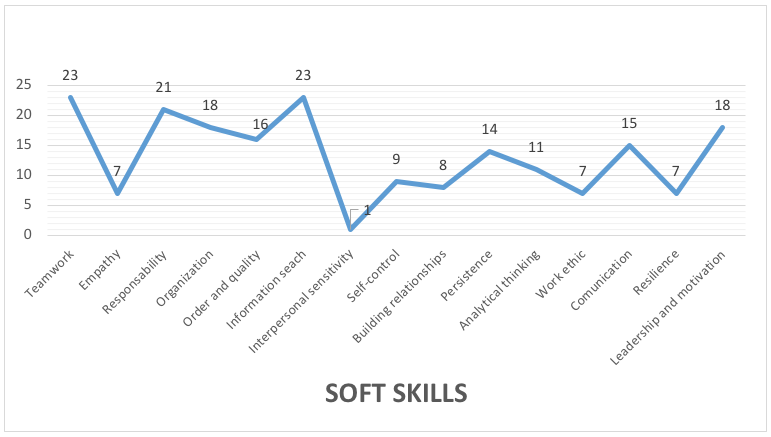
The students were asked according to their criteria what are the hard skills acquired when developing this type of projects. In the Figure 8 can be observed the recognition by students of competencies related to content, where they have been able to experience a substantial advance in results analysis, criticism, interpretation and innovation.
Figure 8
Hard skills recognition in research projects
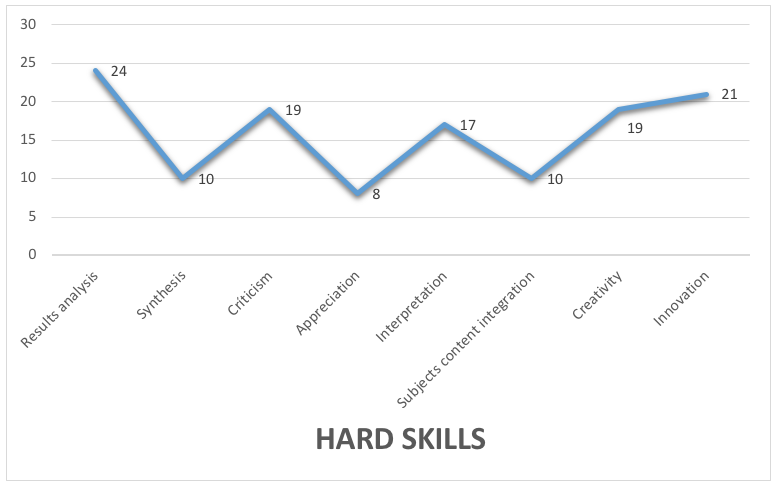
Project impact in the strengthening of the subject’s content can be observed in Figure 9. The results show how the students value work in integrative research projects. For this task, diverse contents of subjects are related, which provide a fundamental practical experience in their professional development.
Figure 9
Project impact in the strengthening
of the subject’s content
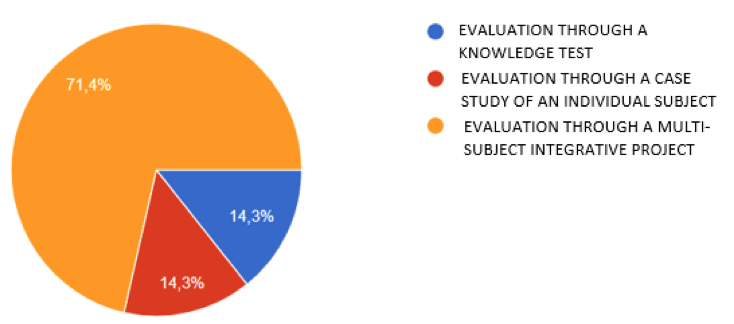
PBL is an effective way to comprehensively assess knowledge, where both hard and soft competences are deepened. PBL provides the students an environment to demonstrate their innovative capacity, analysis and synthesis power, as well as adapting to work with other students. Some of the benefits of PBL include to develop the ability to communicate the results before a heterogeneous audience for the students.
Participation in PBL allows students to strengthen their interest in permanent research and voluntary self-education. In this way, it increases their critical potential in situations where innovative and challenging solutions are needed for the professional and professional world.
The incidence of soft and hard skills is significate, because teachers and student’s attitudes and competences are being renewed to adjust at current needs
Cedeño, E. A. L., & Jimenez, G. A. M. Concepción de la Formación de Competencia en la Educación Superior de los Ingenieros Mediante la Aplicación del Modelo Metodológico en¨ T¨. INNOVA Research Journal, Vol 2, year 2017, number 4, page 148-154.
Chatwattana, P., & Nilsook, P. A Web-based Learning System using Project-based Learning and Imagineering. International Journal of Emerging Technologies in Learning, Vol 12, year 2017, number 5, pages 4-22.
Ding, X. W. The Effect of WeChat-assisted Problem-based Learning on the Critical Thinking Disposition of EFL Learners. International Journal of Emerging Technologies in Learning, Vol11, year 2016, number 12, page 23-29.
Gregorio, R., Ignacio, J., Prats Menéndez, X., Villardi de Montlaur, A. D., & García-Berro Montilla, E. Model rocket workshop: A problem-based learning experience for engineering students. International journal: emerging technologies in learning. Vol 3, year 2008, number 4, page 70-77.
Jacques, S. A Pedagogical Intensive Collaborative Electric Go-Kart Project. International Journal of Engineering Pedagogy (iJEP). Vol 7, year 2017, number 4, page 117-134
Jacques, S., Bissey, S., & Martin, A. (2016). Multidisciplinary Project Based Learning Within a Collaborative Framework. International Journal of Emerging Technologies in Learning, Vol 11, year 2016, number 12, page 36-44.
Llanes, E., Tipanluisa, L., Rocha-Hoyos, J & Portilla, A. Análisis de los factores de emisión en ruta para la ciudad de Quito. En: I Congreso Internacional Ciencias de la Ingeniería Electromecánica y Automotriz CICI 2017. page 128 – 134 Santo Domingo - Ecuador: Editorial UTE. ISBN: 978-9978-389-40-9.
Nicol, D., Thomson, A., & Breslin, C. Rethinking feedback practices in higher education: a peer review perspective. Assessment & Evaluation in Higher Education, Vol 39, year 2014, number 1, page 102-122.
Porter, W. W., Graham, C. R., Spring, K. A., & Welch, K. R. Blended learning in higher education: Institutional adoption and implementation. Computers & Education, Vol 75, year 2014, page 185-195.
1. PhD. Ciencias Técnicas, Academic staff, Facultad de Arquitectura e Ingeniería, Universidad Internacional SEK – Quito y Universidad SEK Chile. Automotive Mechanical Engineer. e-mail: antonio.llanes@uisek.edu.ec
2. MSc. Juan Carlos Rocha-Hoyos, Academic staff, Facultad de Arquitectura e Ingeniería, Universidad Internacional SEK – Quito. Automotive Engineer. e-mail: carlos.rocha@uisek.edu.ec
3. MSc. Diana Belén Peralta Zurita, Academic staff, Facultad de Arquitectura e Ingeniería, Universidad Internacional SEK – Quito. Industrial Design Engineer. e-mail: diana.peralta@uisek.edu.ec
4. PhD in Material Science and Engineering Javier Martínez Gómez, Academic staff, Universidad Internacional SEK – Quito. Research at Instituto Nacional de Eficiencia Energética y Energías Renovables (INER), Quito, Ecuador. e-mail: javier.martinez@uisek.edu.ec
5. MSc. Santiago Celi Ortega, Academic staff, Facultad de Arquitectura e Ingeniería, Universidad Internacional SEK – Quito. Automotive Engineer. santiago. e-mail: celi@uisek.edu.ec